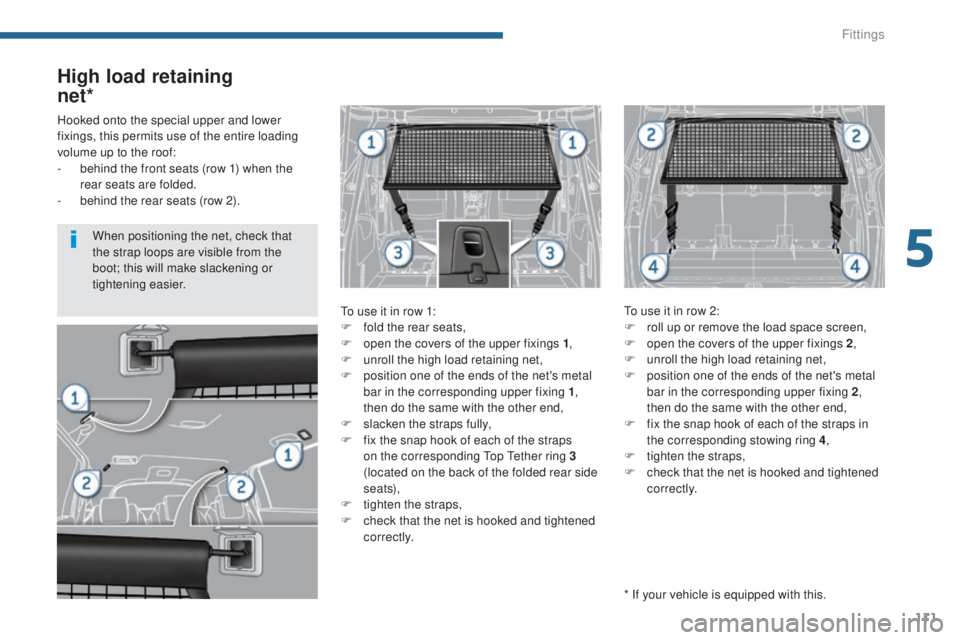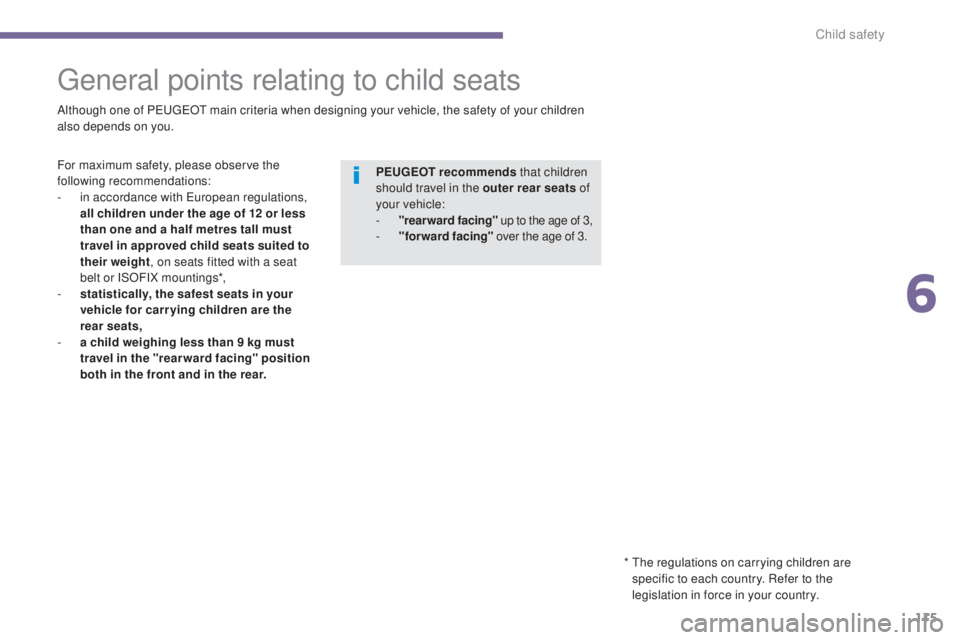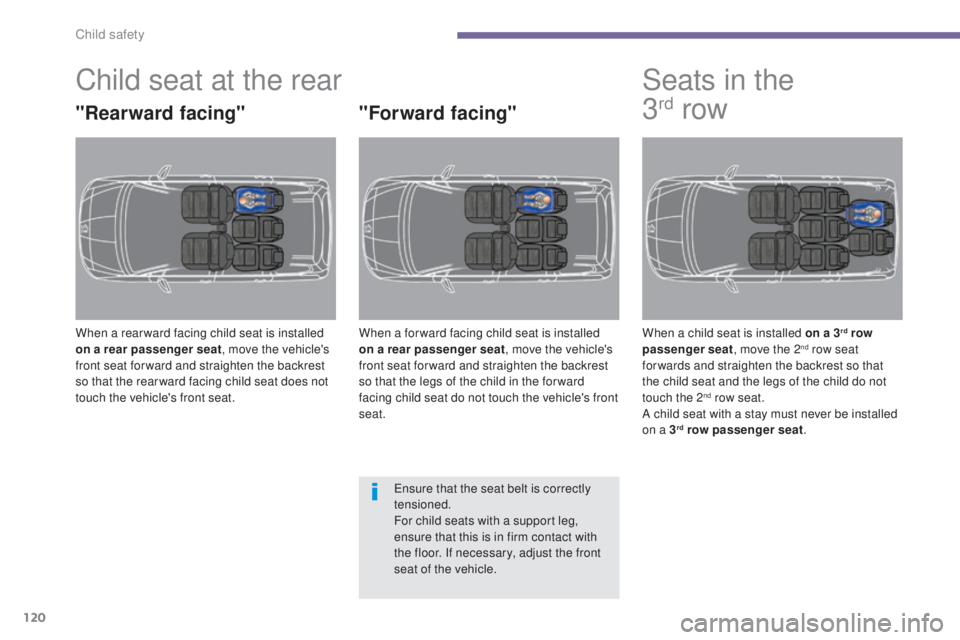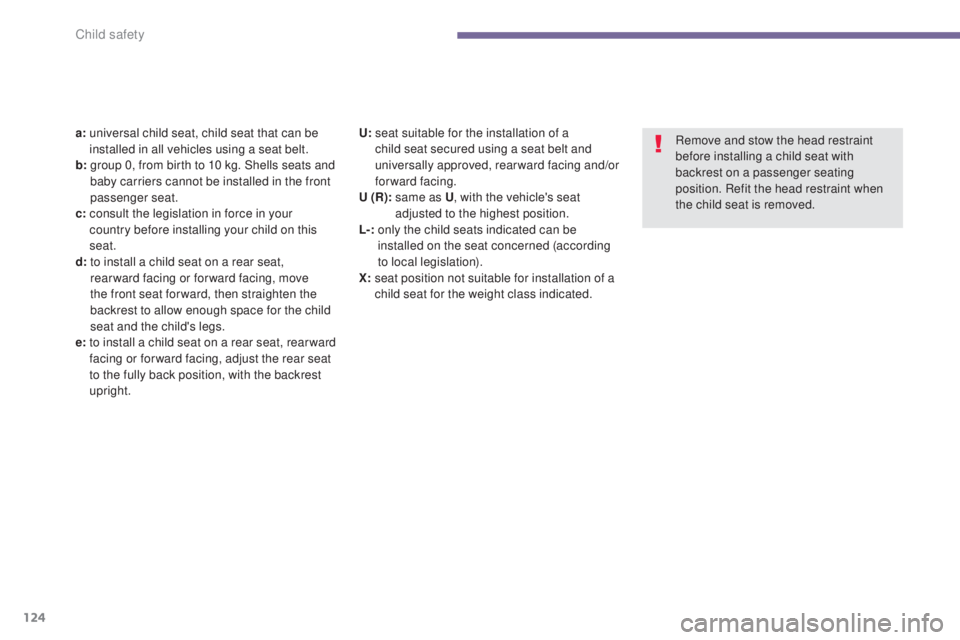Page 113 of 364

111
5008_en_Chap05_amenagements_ed01-2015
High load retaining
net*
To use it in row 1:
F
f old the rear seats,
F
o
pen the covers of the upper fixings 1 ,
F
u
nroll the high load retaining net,
F
p
osition one of the ends of the net's metal
bar in the corresponding upper fixing 1 ,
then do the same with the other end,
F
s
lacken the straps fully,
F
f
ix the snap hook of each of the straps
on the corresponding Top Tether ring 3
(located on the back of the folded rear side
seats),
F
t
ighten the straps,
F
c
heck that the net is hooked and tightened
c o r r e c t l y. To use it in row 2:
F
r oll up or remove the load space screen,
F
o
pen the covers of the upper fixings 2,
F
u
nroll the high load retaining net,
F
p
osition one of the ends of the net's metal
bar in the corresponding upper fixing 2 ,
then do the same with the other end,
F
f
ix the snap hook of each of the straps in
the corresponding stowing ring 4 ,
F
t
ighten the straps,
F
c
heck that the net is hooked and tightened
c o r r e c t l y.
Hooked onto the special upper and lower
fixings, this permits use of the entire loading
volume up to the roof:
-
b
ehind the front seats (row 1) when the
rear seats are folded.
-
b
ehind the rear seats (row 2).
* If your vehicle is equipped with this.
When positioning the net, check that
the strap loops are visible from the
boot; this will make slackening or
tightening easier.
5
Fittings
Page 114 of 364
112
5008_en_Chap05_amenagements_ed01-2015
Luggage retaining net
Hooked onto the stowing rings on the floor and/
or on the load space cover roller, the luggage
retaining net available as an accessory enables
you to secure your luggage.There are 4 possible positions:
-
f
lat at the bottom of the boot,
-
h
orizontal, level with the load space cover,-
v
ertical at the back of the rear seats,
-
f
lat at the bottom of the boot and vertical at
the back of the rear seats.
Fittings
Page 117 of 364

115
5008_en_Chap06_securite-enfants_ed01-2015
General points relating to child seats
Although one of PEUGEOT main criteria when designing your vehicle, the safety of your children
also depends on you.
For maximum safety, please observe the
following recommendations:
-
i
n accordance with European regulations,
all children under the age of 12 or less
than one and a half metres tall must
travel in approved child seats suited to
their weight , on seats fitted with a seat
belt or ISOFIX mountings*,
-
s
tatistically, the safest seats in your
vehicle for carr ying children are the
rear seats,
-
a c
hild weighing less than 9 kg must
travel in the "rear ward facing" position
both in the front and in the rear.
*
T
he regulations on carrying children are
specific to each country. Refer to the
legislation in force in your country.
PEUGEOT recommends
that children
should travel in the outer rear seats of
your vehicle:
-
"
rearward facing" up to the age of 3,
-
"
forward facing" over the age of 3.
6
Child safety
Page 118 of 364
116
5008_en_Chap06_securite-enfants_ed01-2015
Passenger seat in the fully back and
highest position.Forward facing
When a for ward facing child seat is installed on
the front passenger seat, adjust the vehicle
seat to the fully back and highest position,
with the backrest straightened. Leave the
passenger's airbag active.
Rearward facing
When a rear ward facing child seat is installed
on the front passenger seat , adjust the
vehicle seat to the fully back and highest
position, with the backrest straightened.
The passenger's airbag must be deactivated.
Otherwise, the child risks being seriously
injured or killed if the airbag is deployed .
Child seat at the front*
Ensure that the seat belt is properly
tightened.
For child seats with a support leg,
ensure that this is in firm and steady
contact with the floor. If necessary,
adjust the passenger's seat.
*
R
efer to the legislation in force in your country
before installing a child seat on this seating
position.
Child safety
Page 122 of 364

120
5008_en_Chap06_securite-enfants_ed01-2015
Child seat at the rear
"Rearward facing"
When a rear ward facing child seat is installed
on a rear passenger seat, move the vehicle's
front seat for ward and straighten the backrest
so that the rear ward facing child seat does not
touch the vehicle's front seat.
"Forward facing"
When a for ward facing child seat is installed
on a rear passenger seat , move the vehicle's
front seat for ward and straighten the backrest
so that the legs of the child in the for ward
facing child seat do not touch the vehicle's front
seat.
Seats in the
3
rd row
When a child seat is installed on a 3rd row
passenger seat , move the 2nd row seat
for wards and straighten the backrest so that
the child seat and the legs of the child do not
touch the 2
nd row seat.
A child seat with a stay must never be installed
on a 3
rd row passenger seat .
Ensure that the seat belt is correctly
tensioned.
For child seats with a support leg,
ensure that this is in firm contact with
the floor. If necessary, adjust the front
seat of the vehicle.
Child safety
Page 124 of 364
122
5008_en_Chap06_securite-enfants_ed01-2015
Child seats recommended by PEUGEOT
Group 0+: from bir th to 13 kgGroup 1: from 9 to 18 kg
L1
"RÖMER /BRITA X Baby-Safe Plus".
Installed in the rearward facing position. L2
"RÖMER Duo Plus ISOFIX".
Groups 2 and 3: from 15 to 36 kg
L5
" K LI PPA N O pt ima".
From the age of approximately 6 years (22 kg), the booster is used on its own. L6
"RÖMER KIDFIX"
Can be secured using the vehicle's ISOFIX mountings. The child is restrained by the seat belt.
PEUGEOT offers a range of recommended child seats which are secured using a three point seat belt
.
Child safety
Page 125 of 364
123
5008_en_Chap06_securite-enfants_ed01-2015
Installing child seats using the seat belt
In accordance with European regulations, this table indicates the options for installing child seats secured using a seat belt and universally approved (a)
i n accordance with the weight of the child and the seat in the vehicle.
Weight of the child and indicative age
Seat Under 13 kg
(groups 0 ( b) and 0+)
Up to approx 1 year From 9 to 18 kg
(g r o u p 1)
1 to 3 years approx From 15 to 25 kg
(group 2)
3 to 6 years approx From 22 to 36 kg
(group 3)
6 to 10 years approx
Front passenger
seat (c) with height
adjuster U (R)
U (R)U (R)U (R)
Front passenger
seat (c) without
height adjuster X
XXX
5 seats (2 r ow s)
Outer rear seats (d) (e) U* U* U* U*
Centre rear seat (d) (e) UUUU
*
P
recautions are required when fitting a child seat with a support leg . Refer to the section "Installing a child seat with a support leg" for more
information.
6
Child safety
Page 126 of 364

124
5008_en_Chap06_securite-enfants_ed01-2015
Remove and stow the head restraint
before installing a child seat with
backrest on a passenger seating
position. Refit the head restraint when
the child seat is removed.
a:
u
niversal child seat, child seat that can be
installed in all vehicles using a seat belt.
b:
g
roup 0, from birth to 10 kg. Shells seats and
baby carriers cannot be installed in the front
passenger seat.
c:
c
onsult the legislation in force in your
country before installing your child on this
seat.
d:
t
o install a child seat on a rear seat,
rear ward facing or for ward facing, move
the front seat for ward, then straighten the
backrest to allow enough space for the child
seat and the child's legs.
e:
t
o install a child seat on a rear seat, rear ward
facing or for ward facing, adjust the rear seat
to the fully back position, with the backrest
upright. U:
s
eat suitable for the installation of a
child seat secured using a seat belt and
universally approved, rear ward facing and/or
forward facing.
U (R):
s
ame as U , with the vehicle's seat
adjusted to the highest position.
L-:
o
nly the child seats indicated can be
installed on the seat concerned (according
to local legislation).
X:
s
eat position not suitable for installation of a
child seat for the weight class indicated.
Child safety